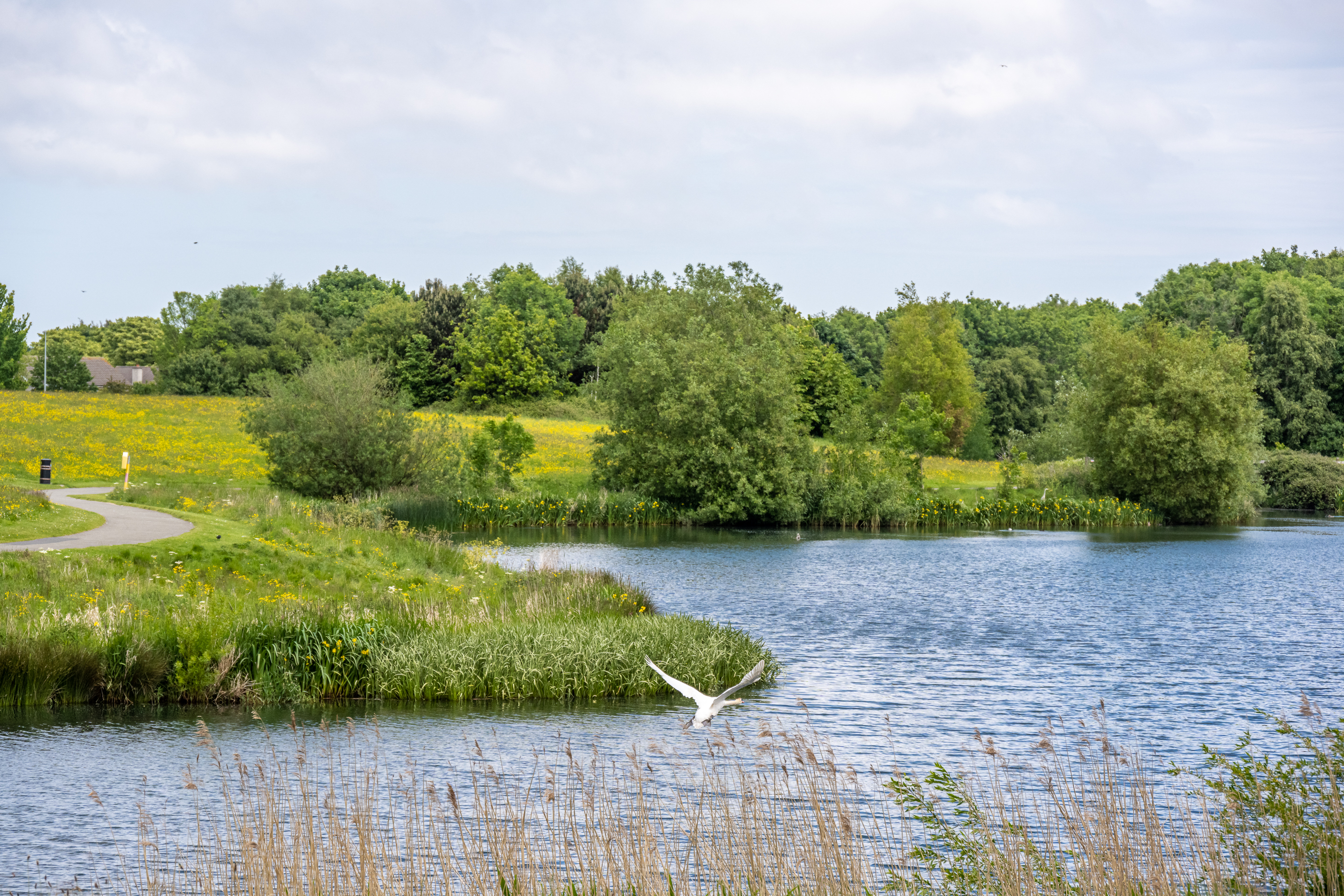What is a Mini Woodland
Mini Woodlands are a small, dense, rapid-growing plantations of entirely native species in an urban setting. They are sometimes referred to as ‘Stepping-Stone-Forests’ as they assist wildlife in moving from one area to another, encouraging genetic diversity as well as providing a natural refuge in urban areas. It is based on the high-density planting method developed by international award-winning botanist Prof. Akira Miyawaki, who started planting mini woodlands in the 1970s. Using native species mini woodlands are designed to mimic a natural habitat with a canopy tree layer, a sub tree layer, a shrub layer, and a ground layer
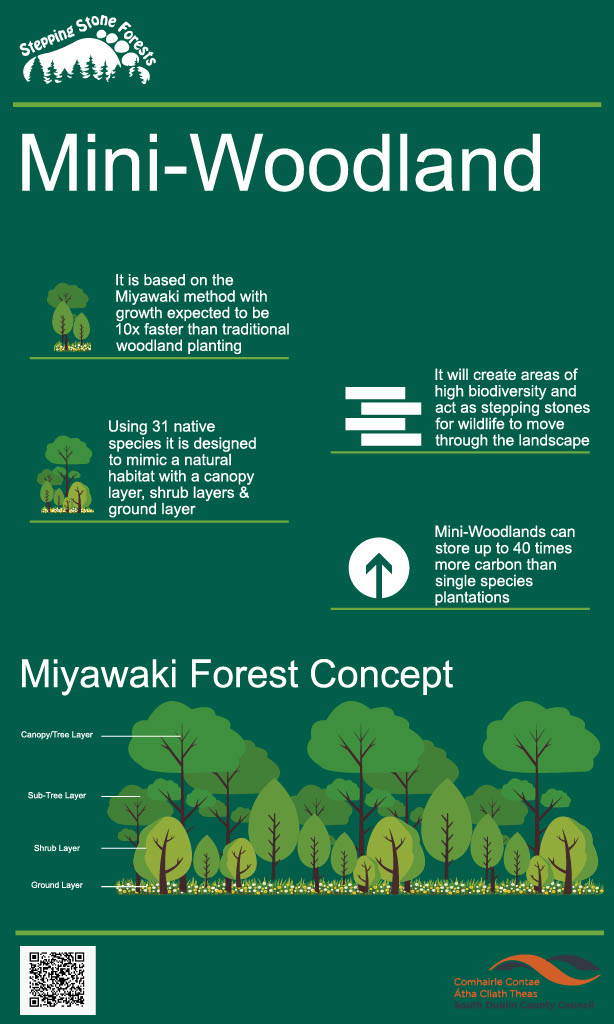
Typical Canopy Tree Layer Species:
Alder, Birch, Oak, Scots Pine, Willow, Yew.
Typical Sub Tree Layer Species:
Blackthorn, Crab Apple, Elder, Holly, Hazel, Hawthorn, Rowan , Wild Cherry.
Typical Shrub Layer Species:
Broom, Guelder Rose, Spindle, Dog Rose.
Typical Ground Layer Species:
Alpine Strawberry, Bluebells, Cow Parsley, Ferns, Foxgloves, Ivy.
The benefits of a Mini Woodland
- Provides Shelter for wildlife including nesting birds, pollinators, and other insects.
- Provides a food source Food - for wildlife including nesting birds, pollinators, and other insects.
- Enhances Wildlife Corridors - A Wildlife (or Ecological) Corridor, is a place where wildlife feels safe travelling from one place to another, under the cover of trees, hedges, logs, long grass, etc.
- Mitigates biodiversity loss by creating diverse habitats that assist in the movement of species, and support genetic diversity.
- Mitigates climate change through carbon sequestration. CO2 absorption is 30 times greater than grassland.
- Mitigates flooding through water retention, absorption and evaporation.
- Mitigates soil erosion through root growth and vegetation cover.
These woodlands have an estimated 20 to 100 times more biodiversity and 40 times more carbon absorption than traditional woodlands. This technique simulates woodlands in small spaces and allows us to see them mature within our own lifetime. The Miyawaki model establishes a 30-year-old natural woodland within 5-10 years and a 100-year-old natural woodland in 15-30 years.
How to create a Mini Woodland
YEAR ONE
- Select a site with a minimum area of 100m2, where the planting will have a positive effect on biodiversity-
The first step is to mow the selected area, lay down cardboard and cover it with 3-5 inches of mulch, and soak with water. This is left for 2-3 months to smother out vegetation in the sod. This mulch treatment also retains moisture and heat and attracts earthworms and other micro-organisms into the soil. This creates the conditions for the rapid plant growth to occur.
- Specify a mix of native tree and shrub species and place an order with a nursery, allowing for 3-4 plants per square meter. Most plants are ordered as bareroot whips (60-90cm height). As ground storey plants are not normally commercially available, we usually ask the nursery to grow them in pots, which we plant after year 2.
- Springtime, the preferred planting season, is when we organise a group of volunteers to plant the whips in a random pattern..
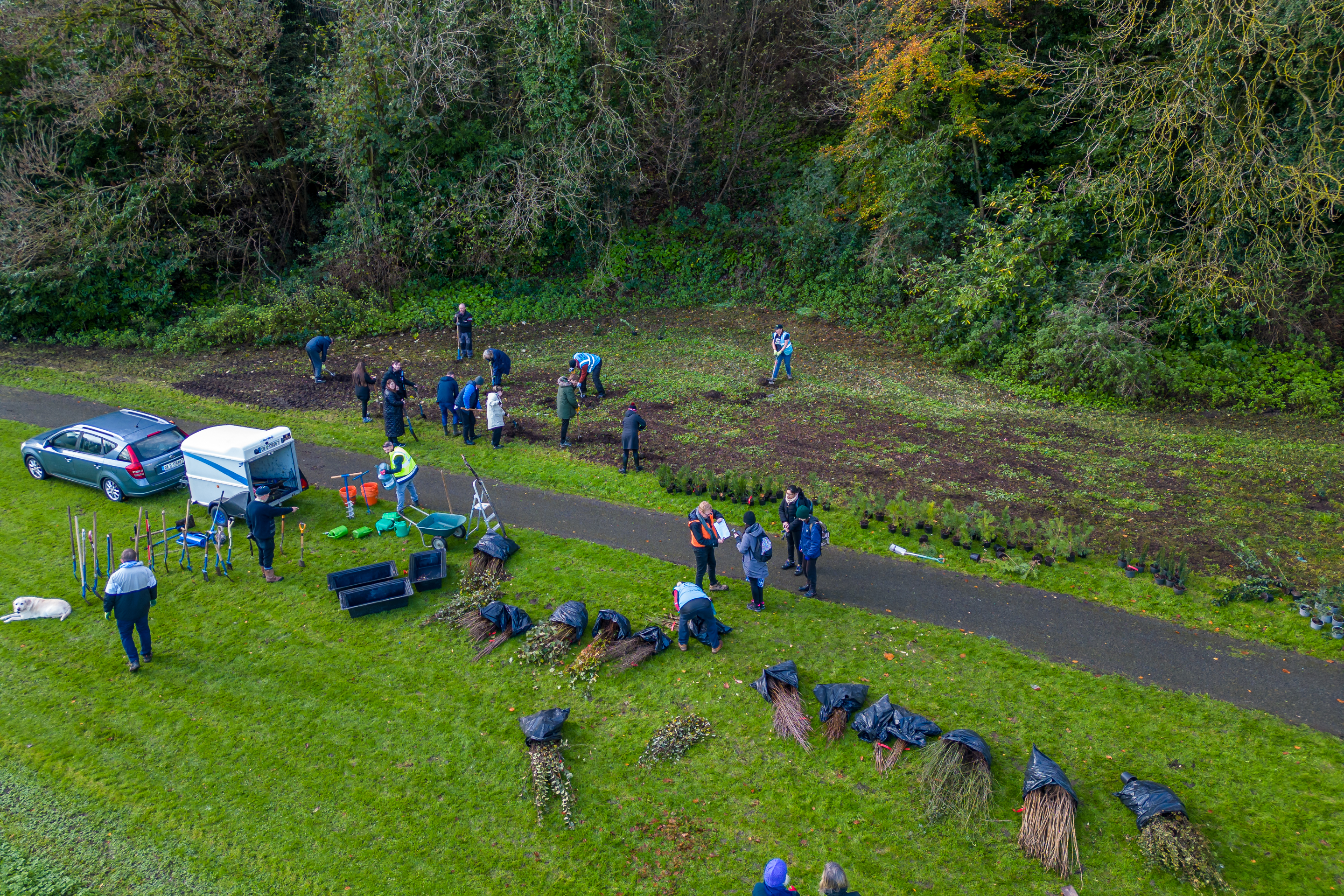
Plants delivered for planting at Mill Lane Park Mini Woodland
YEAR TWO
- The volunteer group return the following summer to remove unwanted growth in the area and to top up the mulch layer (mulch supplied by South Dublin County Council).
YEAR THREE
- In year 3 we return to plant the ground storey plants. This includes plants such as Primrose, Woodrush and Wild Garlic. The aim is to create a woodland with a canopy tree layer, a sub tree layer, a shrub layer and a ground layer.
YEAR FIVE
- These mini woodlands require very minimal maintenance once planted. However, it would be expected that they would need to be evaluated after 5 years and a management plan agreed.
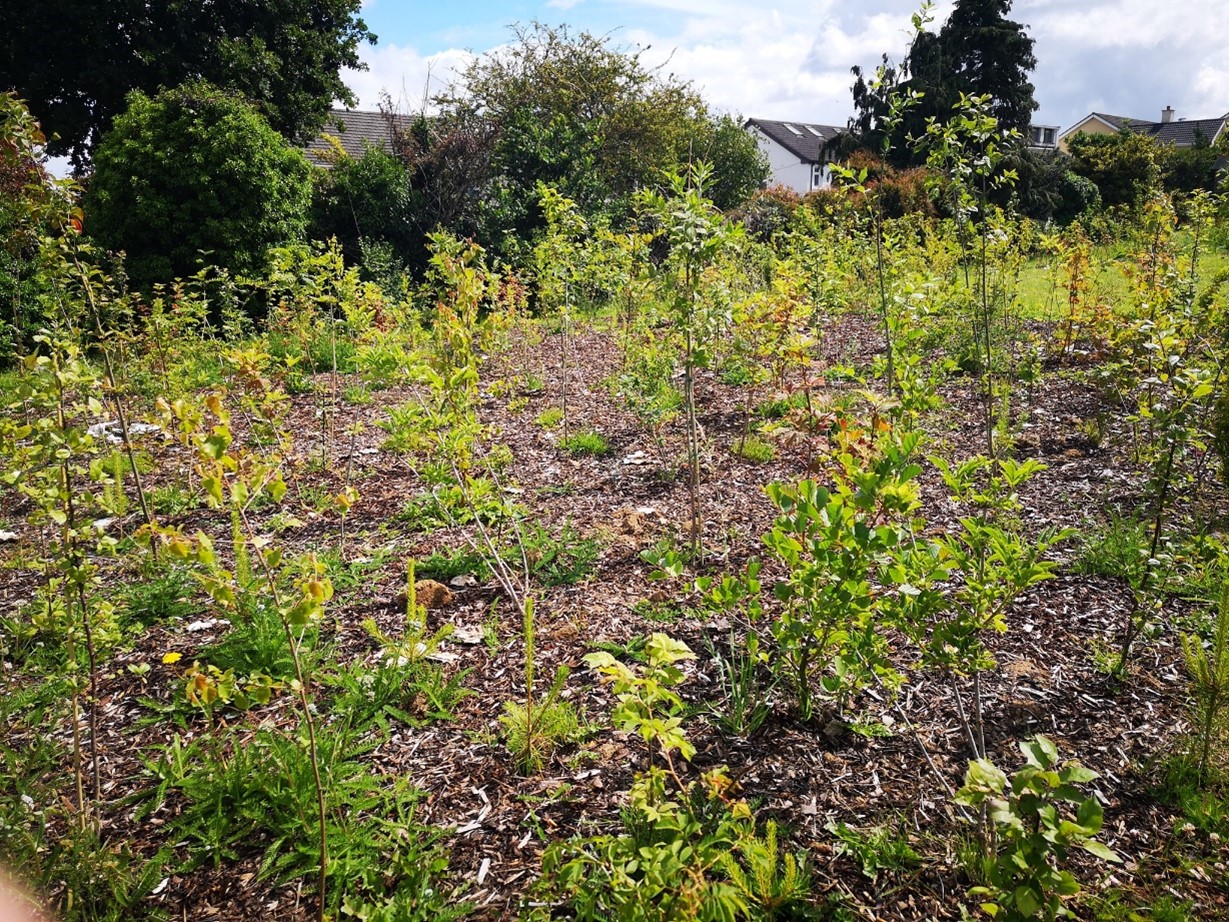
South Dublin County Mini Woodland Locations:
Location | GPS | Size in m2 | Date Soil Prepared | Date Trees Planted | Date of Ground Story Planting | No. of Trees Planted | No. of Ground Story Plants Planted |
Sean Walsh Park | 53.283685, -6.366341 | 300m2 | 05/12/2020 | 27/11/2021 | 28/10/2023 | 900 | 300 |
Mill Lane | 53.354895, -6.364530 | 160m2 | 15/06/2022 | 23/11/2022 |
| 1200 |
|
Greenhills Park | 53.308152, -6.335084 | 400m2 | 26/06/2022 | 02/12/2022 |
| 1200 |
|
Dodder Valley Park | 53.288510, -6.328406 | 846m2 | 20/10/2023 & 21/10/2023 | 01/03/2024 & 02/03/2024 | 01/03/2024 & 02/03/2024 | 4000 | 1200 |
Tymon Park | 53.296610, -6.335664 | 1532m2 | 06/12/2023 & 09/12/2023 | 15/03/2024 & 16/03/2024 |
| 8000 |
|
Corkagh Park | 53.308283, -6.423213 | 800m2 | 15/12/2023 & 16/12/2023 | 08/03/2024 & 09/03/2024 |
| 2500 |
|
Dodder Valley Park/Mount Carmel | 53.288382030765156, -6.330269457672049 | 680m2 | 31/05/2024 & 01/06/2024 | 15/11/2024 &16/11/2024 | 15/11/2024 - 16/11/2024 | 2450 | 875 |
Ballycragh Park | 53.27266408854539, -6.342684177909959 | 551m2 | 23/08/2024 & 24/08/2024 |
|
|
|
|
Griffeen Valley Park | 53.348414, -6.438804 | 800m2 | 26/07/2024 & 27/07/2024 | 13/12/2024 & 14/12/2024 |
| 2002 | 298 |
Clondalkin Park | 53.318656, -6.402657 | 600m2 | 13/09/2024 & 14/09/2024 |
|
|
|
|
Dodder Valley Park/Avonmore Road | 53.2844247706093, -6.343274189239261 | 1550m2 | 03/10/2024 & 05/10/2024 |
|
|
|
|
Sean Walsh Park
This pilot project was organised between South Dublin County Council and volunteers from the Tallaght Litter Mugs, The Stepping Stone Forest Group, and the Dodder Action Group. Three 100m2 areas were planted using the Miyawaki method.
Site Prep: 2020
Tree Planting: 2021 - 900no. trees planted
Ground Story Planting: 2023 - 300no. ground story plants planted
Sean Walsh Park Mini Woodland - Video
Mill Lane Park
Approximately 80 volunteers including 21 schoolboys and their teachers from St Lorcan’s Primary School, 20 staff from Ernst and Young, Palmerstown Tidy Towns, Dodder Valley Action and Stewarts Care took part.
Site Prep: 2022
Tree Planting: 2022 - 1200no. trees planted
Greenhills Park
This project was organised between South Dublin County Council, and volunteers from The Stepping Stone Forest Group, the Dodder Action Group, and Temple Manor / Wilkins Residents Association.
Site Prep: 2022
Tree Planting: 2022 - 1200no. trees planted
Dodder Valley Park, Firhouse
This project was organised between South Dublin County Council, and volunteers from The Dodder Action Group, The Stepping Stone Forest Group, Willbrook Litter Mugs, South Dublin Volunteer Centre, Citywest Refugee Centre, and Templeogue Village Tidy Towns.
Site Prep: 2023
Tree Planting: 2024 - 4000no. trees planted
Ground Story Planting: 2024 - 1200no. ground story plants planted
Tymon Park
This project was organised between South Dublin County Council, and volunteers from Cairde Pháirc Thigh Motháin - Friends of Tymon Park, Stepping Stone Forest, Dodder Action, Stepping Stone Forests, Willbrook Litter Mugs, South Dublin Volunteer Centre, Citywest Refugee Centre, Templeogue Village Tidy Towns, Students of Coláiste de hÍde, EY, PJ Hegarty & Sons, Amdocs.
Site Prep: 2023
Tree Planting: 2024 - 8000no. trees planted
Corkagh Park
This project was organised between South Dublin County Council, Clondalkin Tidy Towns, Moyle Park College Students, Stewarts Hospital Kaizen Hub, Dodder Action, Stepping Stone Forests, South Dublin Volunteer Centre, Citywest Refugee Centre.
Site Prep: 2023
Tree Planting: 2024 - 2500no. trees planted
Mini Woodlands
Photo Gallery
Volunteers preparing the Dodder Valley Site October, 2023.
Volunteers planting the Dodder Valley Site March, 2024.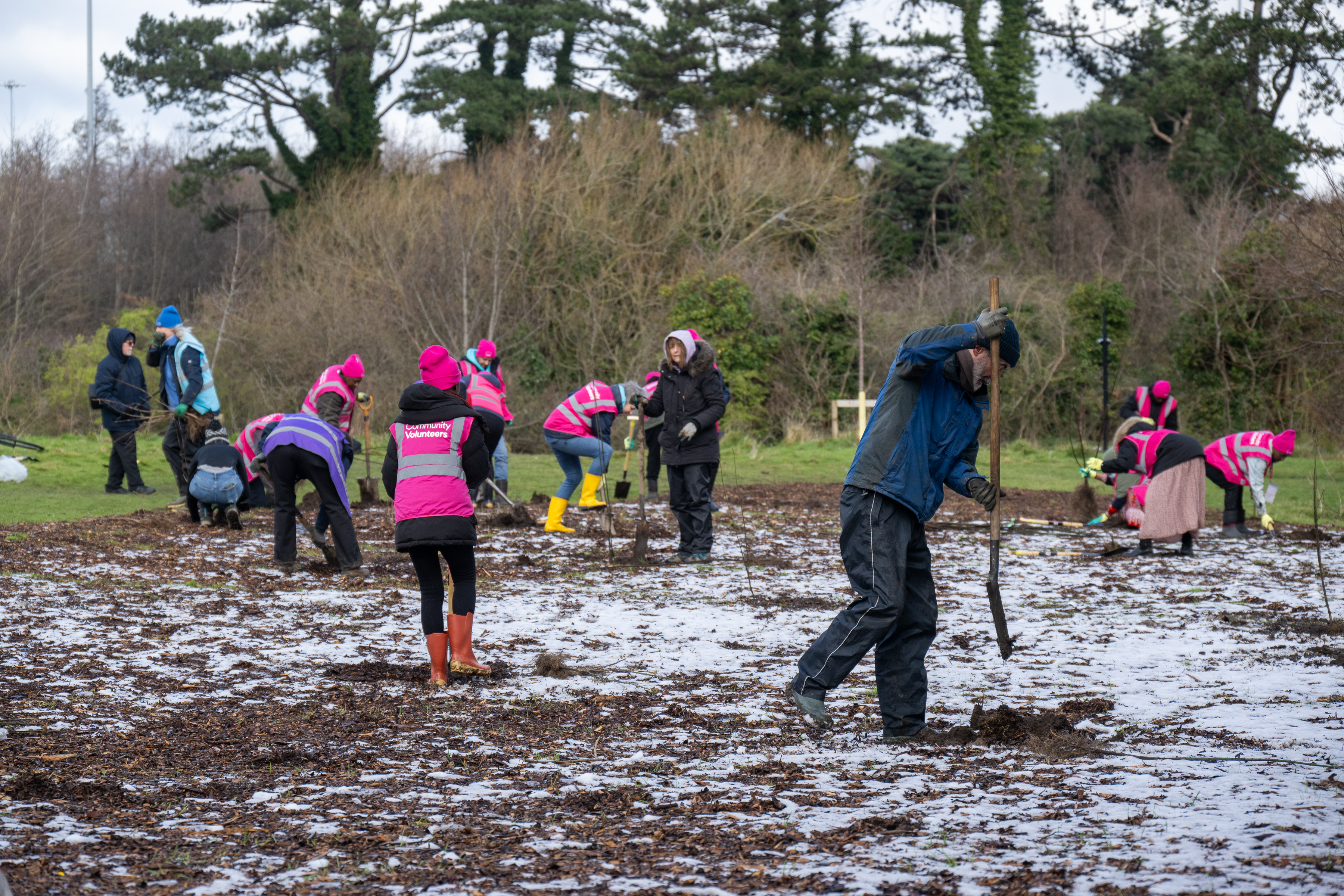
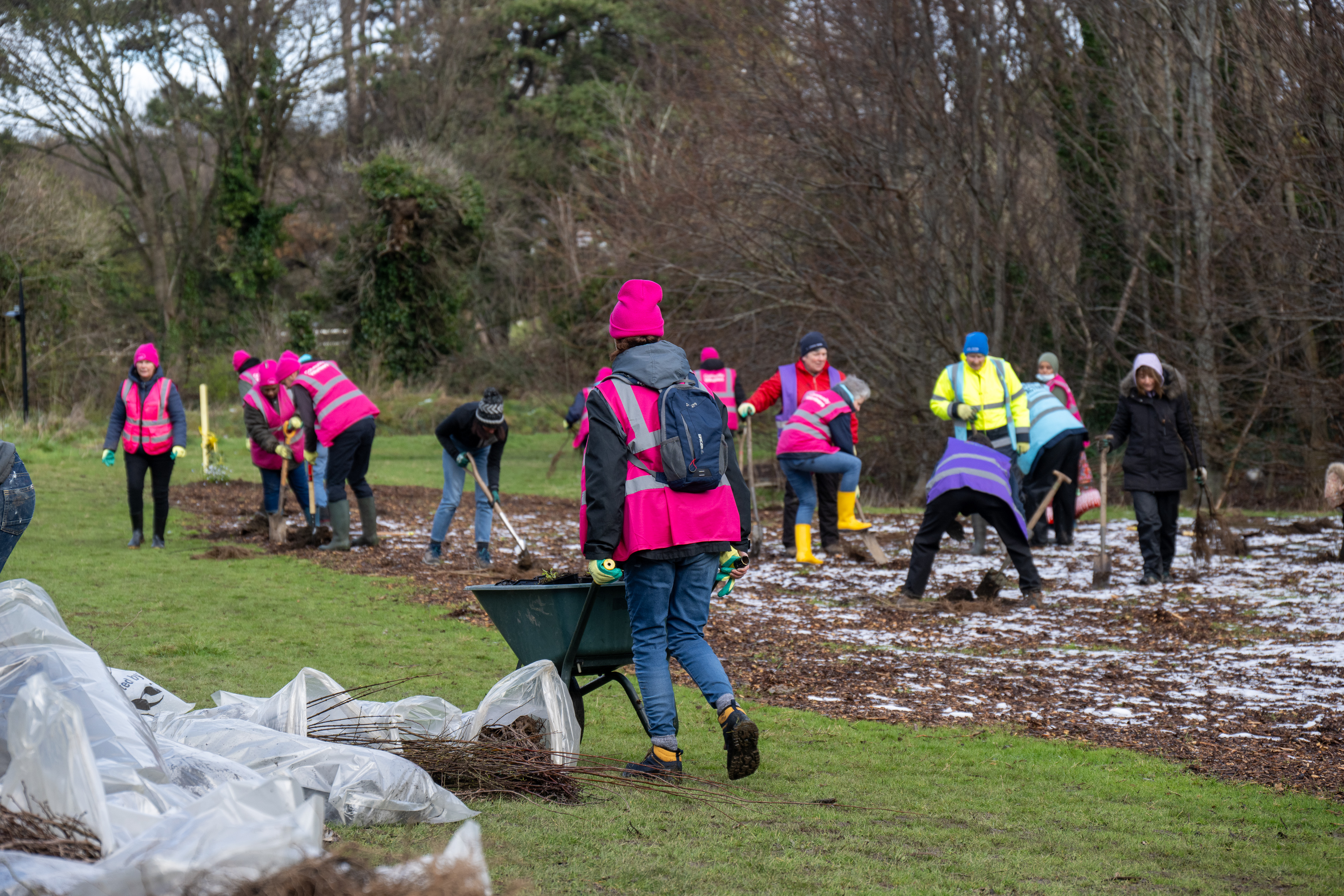
Volunteers preparing the Tymon Park Site December, 2023.
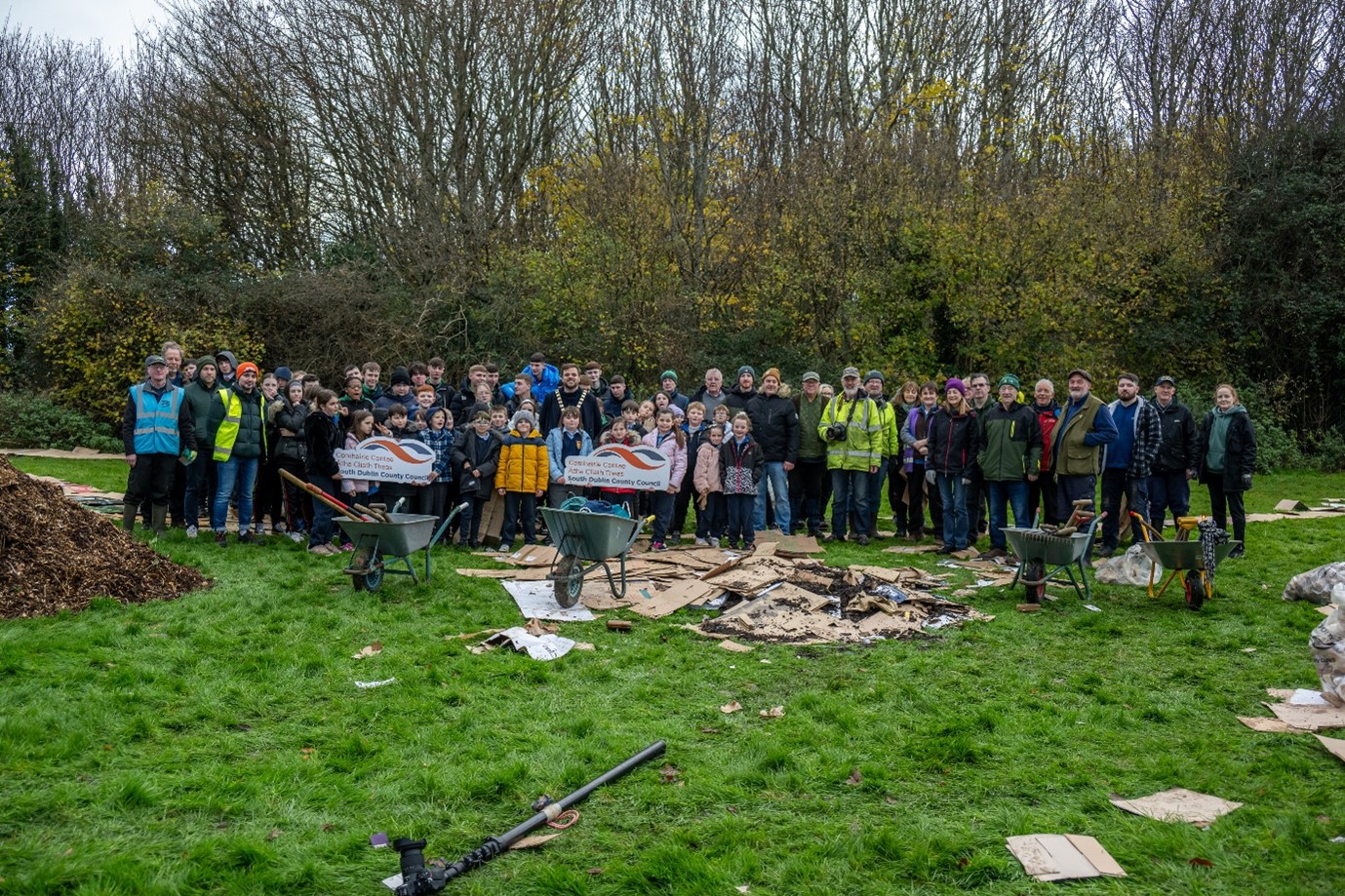
Volunteers preparing the Tymon Park Site March, 2024.
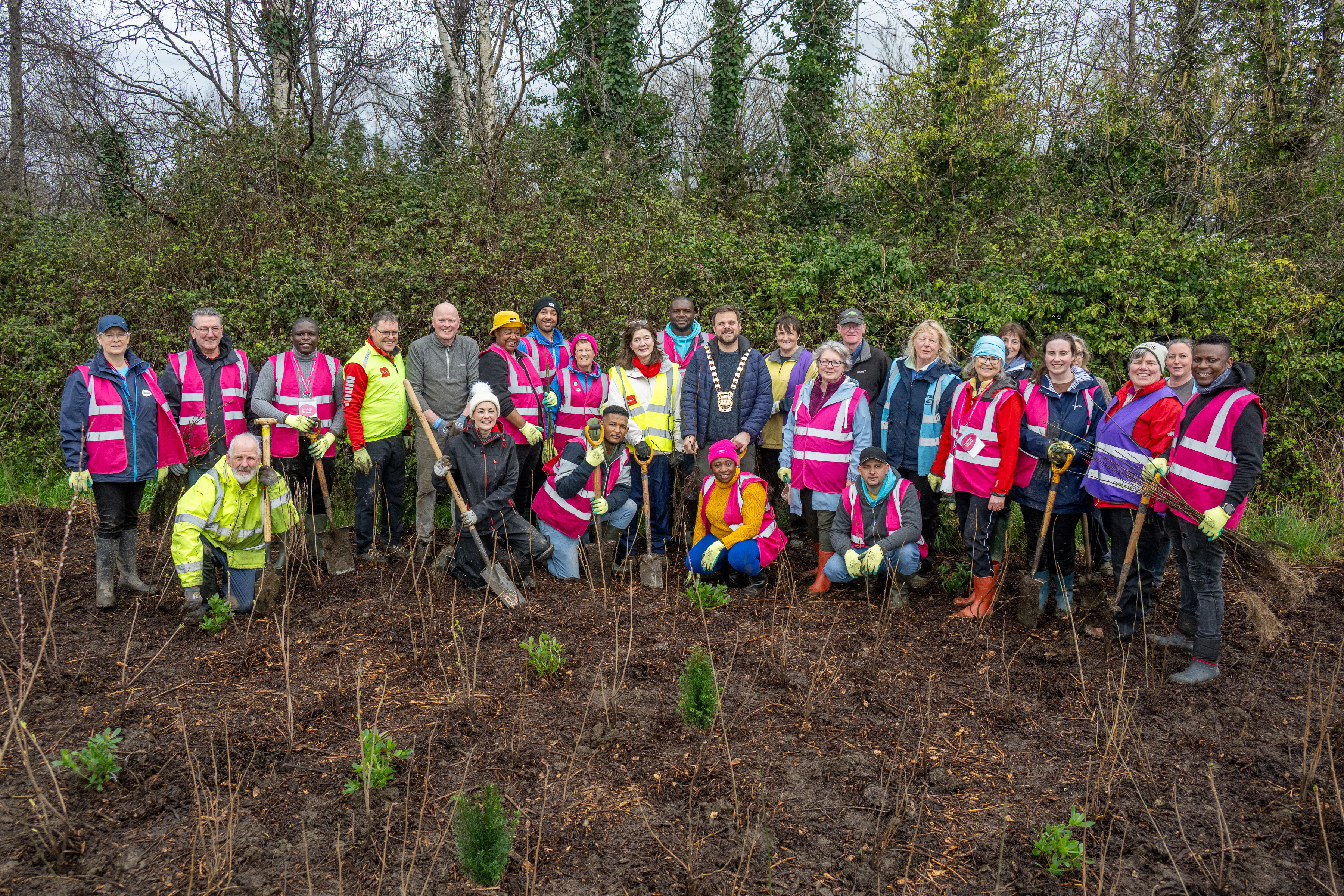
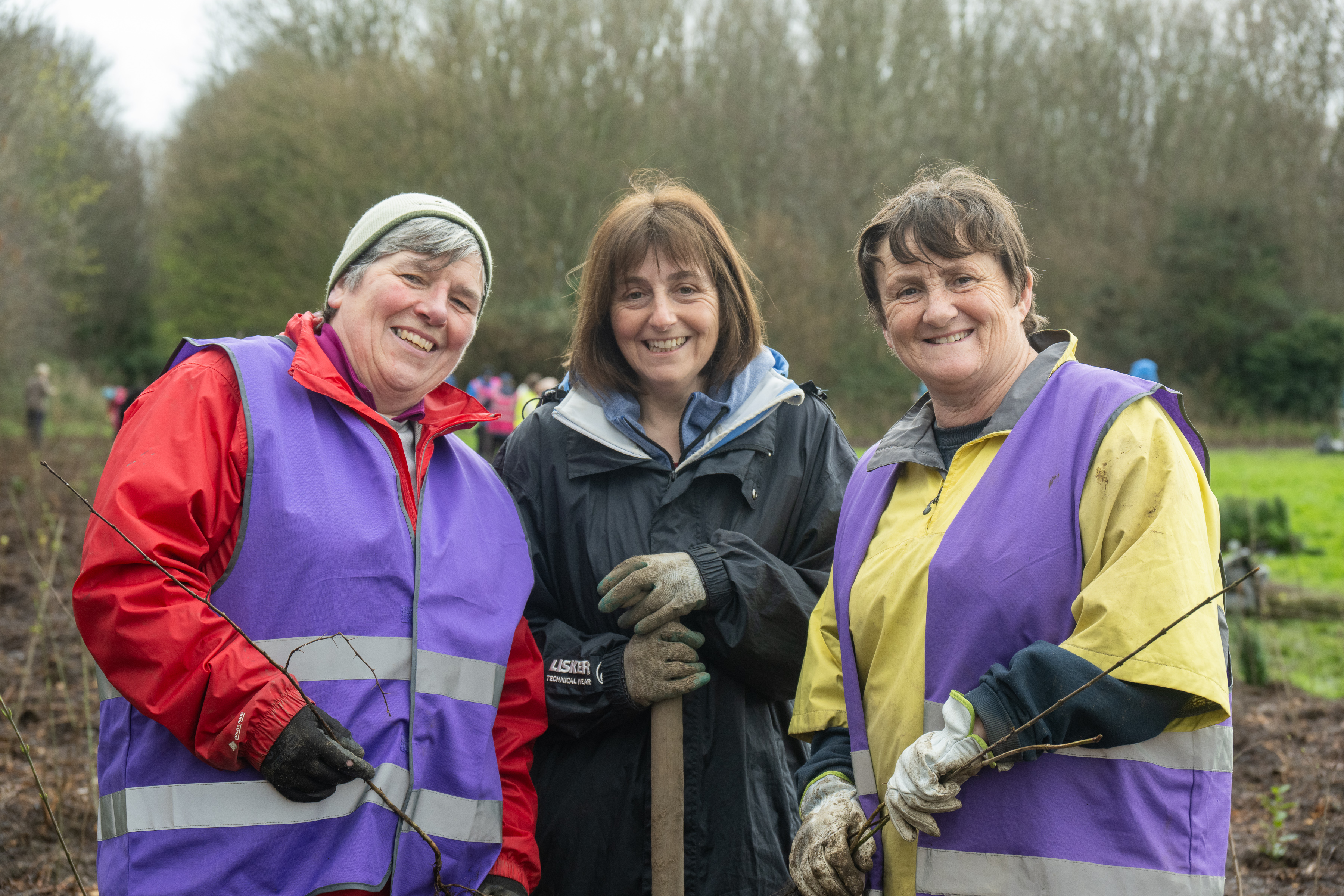
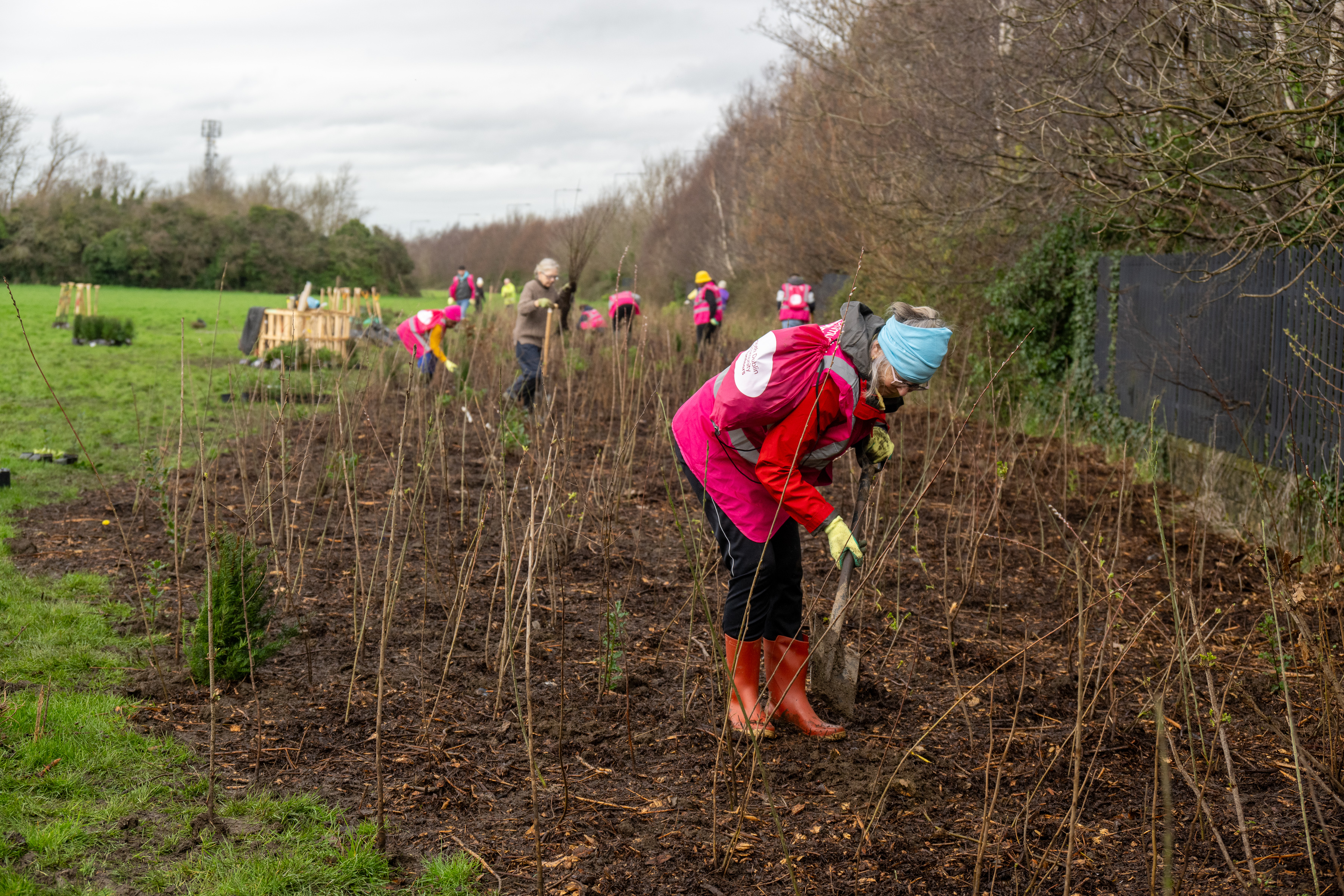
Future Mini Woodland Proposals
South Dublin County Council are identifying suitable locations to plant more mini woodland areas to enhance the green infrastructure corridors in the County. All projects are organised in collaboration with local Councillors and community members. The long-term support of a volunteer group is critical in the installation and development of mini woodland areas.


